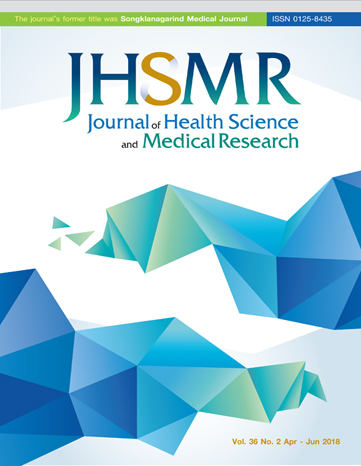The Prevalence of Alcohol and Substance Use Among Medical Students at The Faculty of Medicine, Prince of Songkla University, 2016
DOI:
https://doi.org/10.31584/jhsmr.2018.36.2.4Keywords:
drinking alcohol, epidemiology, medical students, prevalence, substance use, trendsAbstract
Objective: To study the prevalence of alcohol and substance use among medical students.
Material and Methods: A cross-sectional study surveyed Prince of Songkla University medical students in 2016. Questionnaires for demographic data, the Alcohol Use Disorder Identification Test (AUDIT), experience with alcohol and substance abuse, and the Patient Health Questionnaire-9 Thai version (PHQ-9) were used. We analyzed the data in order to describe the behavior of subjects by descriptive statistics. The factors associated with alcohol used were analyzed by chi-square test and logistic regression.
Results: Seven hundred thirty-nine (70.1%) of medical students completed the questionnaires. Participants, 56.0% were female and 44.0% were male. Mean age was 21.2 years old; 53.3% have drunk alcohol; the gender proportion of drinkers was 60.0% of males and 48.1% of females. By AUDIT, 23.1% of medical students were high-risk drinkers. The most common reason for alcohol consumption was social engagement (91.9%) and the most common reason for not drinking was having knowledge about the harmful health effects of alcohol (51.2%). Of the medical students, 7.6% had experience with substance use. The drugs most commonly used were cigarettes (5.3%) and baraku (4.6%). According to the PHQ-9, 11.2% of all medical students, 12.6% in males and 10.1% in females had depression. However, these high levels of depression did not associate with a high-risk of alcohol consumption. The significant factors that associated with high-risk drinking were gender [odd ratio (OR)=1.9 (1.1-3.4)] and experience with substance use [OR=3.8 (2.0-7.3)].
Conclusion: Half of medical students drank alcohol and approximate 1 in 10 had experience with substance use. Gender and experience with substance use were the significant factors that correlated with high-risk drinking.
References
performance. J Biomed Educ 2015. Doi: 10.1155/2015/149509.
2. Pickard M, Bated L, Dorian M, Greig H, Saint D. Alcohol and drug use in second-year medical students at the University of Leeds. Med Educ 2000;34:148-50.
3. Boland M, Fitzpatrick P, Scallan E, Daly L, Herity B, Horgen J, et al. Trends in medical student use of tobacco, alcohol and drugs in Irish university, 1973-2002. Drug Alcohol Depend 2006;85:123-8.
4. Baldwin DC Jr, Hughes PH, Conard SE, Storr CL, Sheehan DV. Substance use among senior medical students: a survey of 23 medical schools. JAMA 1991;265:2074-8.
5. Croen LG, Woesner M, Herman M, Reichgott M. A longitudinal study of substance use and abuse in single class of
medical students. Acad Med 1997;72:376-81.
6. Newbury BD, White M, Kamali F. Factors influencing alcohol and illicit drug use among medical students. Drug Alcohol Depend 2000;59:125-30.
7. Forney MA, Ripley WK, Forney PD. A profile and prediction study of problem drinking among first-year medical students. Int J Addict 1988;23:767-79.
8. Tchen G, Carter A, Gibbons P, McLaughlin P. What is the relationship between indicators of stress and academic
performance in first year university students? a prospective study. JIR 2001;40:463-73.
9. Rosenthal JM, Okie S. White coat, mood indigo depression in medical school. N Engl J Med 2005;353:1085-8.
10. Sreeramareddy CT, Shankar PR, Binu VS, Mukhopadhyay C, Ray B, Menezes RG. Psychological morbidity, sources of
stress and coping strategies among undergraduate medical students of Nepal. BMC Med Educ 2007;7:26.
11. Sahraian A, Sharifian M, Omidvar B. Prevalence of substance abuse among the medical students in Southern Iran. Shiraz E Med J 2010;11:198-202.
12. Arunpongpaisal S, Rangsikachi P, Virasiri S. Prevalence of alcohol drinking problems among medical students at Khon Kaen University. J Psychiatr Assoc Thailand 2006;51:155-66.
13. Pitanupong J, Kanapikhu S. Happiness status and related factors among clinic medical students of Prince of Songkla
University, 2015. Songkla Med J 2017;35:229-38.
14. Saunders JB, Aasland OG, Babor TF, de la Fuente JR, Grant M. Development of the Alcohol Use Disorders Identifiation Test (AUDIT): WHO collaborative project on early detection of persons with harmful alcohol consumption--II. Addiction 1993;88:791-804.
15. Integrated Management for Alcohol Intervention Program. The alcohol use disorders identification test [homepage on the Internet]. Chiang Mai: Integrated Management for Alcohol Intervention Program; 2009 [cited 2016 Dec 2]. Available from: http://www.i-mapthailand.org/site/media/knowledge/practitioners/audit_self_test.pdf
16. Lotrakul M, Sumrithe S, Saipanish R. Reliability and validity of the Thai version of the PHQ-9. BMC Psychiatry 2008;8:46.
17. Assanangkornchai S, Mukthong A, Intanont T. Prevalence and patterns of alcohol consumption and health-risk behaviors among high school students in Thailand. Alcohol Clin Exp Res 2009;33:2037-46.
























